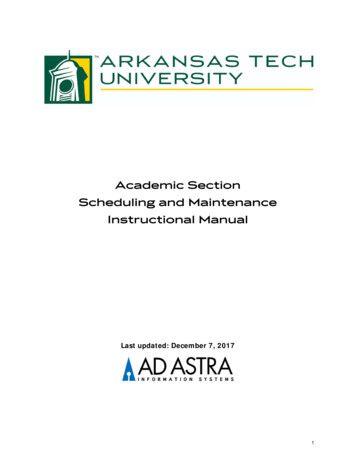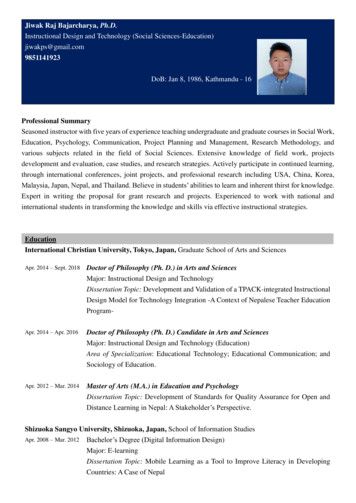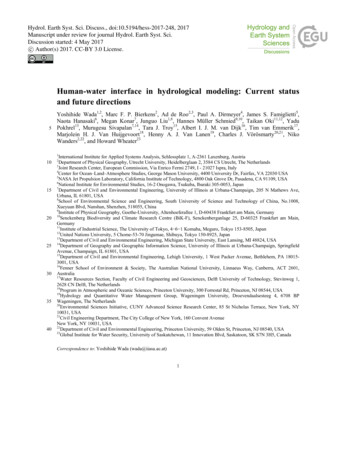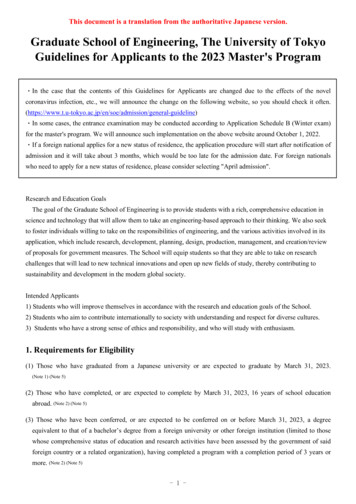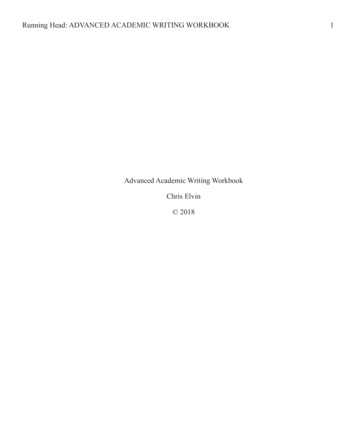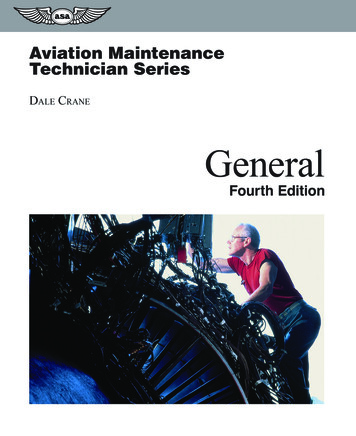
Transcription
Version 7.0Upper LevelSSAT Practice Test 1
This page is intentionally blank.
Writing Sample TipsUpper Level test-takers are given 25 minutes to respond to one of two prompts. UpperLevel students are given a choice between a personal essay prompt and a general essayprompt.Your official SSAT writing sample will not be graded but is sent to the admissionsoffices of the schools to which you apply.Read each prompt carefully and decide which you prefer and think will be easier toanswer. You can then organize what you plan to say before you begin writing (paper foroutlining your writing sample will be provided at the official exam).We recommend that for either prompt, you start by deciding on your main point (yourthesis) and then outlining your essay (we have provided some lines under “Notes.”)Your essay should have an introduction with your main point, 2-3 body paragraphs ofevidence supporting your main point, and a summarizing conclusion. Decide what yoursupporting evidence paragraphs will be before you begin writing.Remember to make sure your handwriting can be read. Stay within the margins of theanswer sheets. If you wish to change something you have written you may neatly strikethrough the words you want to “delete.” You are given 2 lined pages; however, you donot need to entirely fill both pages.If you have time, we recommend that you read over what you have written. Often whenstudents write quickly, they make careless mistakes. Here are some helpful TestInnovators reminders:üüüüüCheck to make sure you have not left out any words.Look over your spelling. Are there any words that don’t look right to you?Have you capitalized words in odd places or forgot to capitalize proper nouns?Does your comma use look okay?Have you used complete sentences? Remember not to connect two full sentenceswith a comma.ü Did you use the correct spelling of homophones such as there/their/they’re, your/you’re, and two/to/too?Be your own editor and good luck!
Upper Level 1Writing SampleChoice of 2 PromptsTime: 25 minutesSchools would like to get to know you through an essay you write. If you choose to write apersonal essay, base your essay on the topic presented in A. If you choose to write a generalessay, base your essay on the topic presented in B. Please fill in the circle next to your choice.On the SSAT you will be given extra paper for working out your thoughts. You may use thelines under “Notes” below to plan. Please remember to start your writing sample on thefollowing page. What is a career that you might appreciate working in? What are some of your skills orabilities that might help you to do well in this line of work? What do you think are the three most important skills to learn or develop in high school?Notes5
Use this page and the next to complete your writing sample.
QS2Section 2Quantitative (Math) Section25 QuestionsTime: 30 minutesIn this section, each question is followed by five answer choices. You may write in thetest booklet. For each answer you choose, fill in the corresponding bubble on your answerdocument.Note: In this section, you can assume that the figures that accompany the questions areaccurately drawn EXCEPT when the question states that a particular figure is not drawnto scale.SAMPLE QUESTION:1,567 – 382 (A) 1,075(B) 1,083(C) 1,185(D) 1,195(E) 1,243The correct answer is 1,185, so choice C is darkened.Sample Answer(A) (B) (C) (D) (E)
Upper #1 - QS #11.3.At a central train station, there are 4different train routes with trains thatleave every 6 minutes, 10 minutes, 12minutes, and 15 minutes. If each traincan hold up to 200 passengers, what isthe maximum number of passengers whocan leave the station on a train in onehour?In Figure 5, if lineis parallel to line, what is the measure of angle(A) 800(B) 2,000(A)(C) 3,000(B)(D) 3,200(C)(E) 5,000(D)(E)2.One popcorn kernel weighs 1.23 grams.If a package of popcorn kernels weighs 2kilograms, approximately how manypopcorn kernels does the package hold?4.(A) 16Letbe an integer such that. What is the probability thatis a multiple of 3 but NOT a multiple of4?(B) 163(A)(C) 615(B)(D) 1,626(C)(E) 6,150(D)(E)5.48 is what percent of 200?(A) 14%(B) 20%(C) 24%(D) 40%(E) 48%10Go on to the next page.
Upper #1 - QS #16.If10. When, thenandis the value of(A) 0(B)(A) 3(C) 1(B) 6(D) 24(C) 12(E) 25(D) 15, what?(E) 247.8.If, what is the sum of thepossible values of?11.(A) 169(A)(B) 338(B)(C) 361(C)(D) 430(D)(E) 530(E)A rectangular yard 65 feet long and 20feet wide is to be covered with sod. If thetotal cost of the sod is 7,800, what is thecost of the sod per square foot?12. Setsare defined as follows.SetSet(A) 92What is the intersection of Set?(B) 65(C) 46and Set(A) {3, 6}(D) 16(B) {3, 6, 17}(E) 69.and(C) {2, 3, 4, 17}(D) {1, 2, 4, 20, 24, 28, 32}Which of the following could be the valueofif?(E) {1, 2, 3, 4, 6, 11, 13, 17, 20, 24, 28,31, 32}(A)(B)(C)(D)(E)11Go on to the next page.
Upper #1 - QS #113. In Figure 2, the perimeter of the six-sided14. Using the graph in Figure 4, which yearshape is 50. The perimeter of areais21. What is the value of? (Figurenot drawn to scale)had the largest increase in the number ofvisitors compared to the year before?(A) 2009(B) 2008(C) 2007(D) 2004(A) 2(E) 2003(B) 7(C) 915. Judy plans to purchase pizza for 11(D) 16guests invited to her movie party. Sheexpects each guest will eat an average of3 slices of pizza. There are 8 slices ofpizza in one whole pizza. How manypizzas must she buy?(E) It cannot be determined from theinformation given.(A) 2(B) 3(C) 4(D) 5(E) 612Go on to the next page.
Upper #1 - QS #116. Curran’s favorite store is offering a 20%18. Jami surveys 120 people and asks wherediscount on all hats. If she buys 2 ormore hats, she gets an additional 15% offthe sale price. If Curran buys 4 hats thateach cost 25 before the sale, how muchdoes she pay total after both discounts?they do their grocery shopping. Ninetyfive people respond that they do theirgrocery shopping at a grocery store and84 people respond that they do theirgrocery shopping at a farmer’s market.Assuming that each person shops at oneof these two places, how many peopleshop at both a grocery store and afarmer’s market?(A) 65(B) 68(C) 70(D) 80(A) 11(E) 85(B) 25(C) 3617. In the figure,(D) 59is a regularoctagon. Which of the following paths isthe shortest distance?(E) 10919. What is the quotient of 0.74 and 3.7?(A)(B)(C) 2(D) 5(E) 50(A)(B)(C)(D)(E)13Go on to the next page.
Upper #1 - QS #120. Find the area of the irregular shape22. On Figure 3, pointwill be located atthe midpoint of sideand pointwillbe located at the midpoint of side.Which lettered point will be located onthe line segment?below.(A)(B)(C)(D)(A) 119(E)(B) 80(C) 10823. The coordinates of triangle(D) 94,length of line(E) It cannot be determined from the, and?are:. What is theinformation given.21. If the average of four consecutive evenintegers is 45, what is the smallestinteger?(A) 38(B) 40(C) 42(D) 44(E) 48(A) 5(B)(C) 6(D)(E) 2514Go on to the next page.
Upper #1 - QS #124. The average age of three female geese isfour years and ten months and theaverage age of five male geese is fiveyears and three months. Approximatelywhat is the average age of all eightgeese?(A) 4 years(B) 5 years(C) 5.5 years(D) 6 years(E) 6.6 years25. In Figure 7, the length is 22the length ofis 18and the length ofis 12What is the length, inof?(A) 4(B) 6(C) 16(D) 18(E) 2815STOP. Do not go onuntil told to do so.
This page is intentionally blank.
RS3Section 3Reading Section40 QuestionsTime: 40 minutesRead each passage carefully and decide on the basis of the passage which one of the fiveanswer choices best answers each question.
Upper #1 - RSQuestions 1-5Imagine a world in which you hear colors. Or maybe you feel music onyour skin. Perhaps you even taste words. If these kinds of experiences soundfamiliar, you may be one of the few people with a unique sensory conditionLine called synesthesia.5Sharing one of the same roots as the word anesthesia (meaning “nosensation”) synesthesia means “joined sensation.” It’s a condition in whichthe stimulation of one sense (for example, taste) stimulates a totally differentsense, like sight. So individuals with synesthesia (about one in every 27people) have “mixed senses.”10People with synesthesia might hear sounds in response to smell, experiencea smell in response to touch, or feel something in response to sight. One ofthe most common forms of synesthesia is seeing letters and numbers indifferent colors. For example, a synesthete (a person with synesthesia) mightsee the letter “T” as always colored in blue, or the letter “R” as dark brown.15Once a form of synesthesia is established in childhood, these associationsremain fixed for life.Scientists who study synesthesia use brain scanning technology to showthat the brains of synesthetes are “wired” differently than people without thecondition. According to research, synesthesia occurs when areas of the brain20that process different senses are “cross-wired.” So for someone whoperceives colors when hearing words, the part of the brain involved withvision activates in response to sound.One of the most fascinating things about synesthesia is that everybodywho has it experiences it differently. No two synesthetes share the same25associations. For example, one synesthete may see the number “9” coloredpurple while another synesthete may see “9” as bright red. In this way,synesthesia demonstrates that each of us perceives and experiences the worlduniquely.18Go on to the next page.
Upper #1 - RS1.3.In the last paragraph (lines 23-28) theauthor states that no two people withsynesthesia have the same associationsin order to suggest that(A) presenting evidence to confirm thatsynesthesia is an official disorder.(B) describing why some people see the(A) science has proven that synesthesialetter “T” as blue.exists.(C) explaining differences in the brains of(B) people without synesthesia live dullerhumans with and without synesthesia.lives.(D) how synesthetes’ experience multiple(C) all people, even those withoutsenses simultaneously.synesthesia, experience the worlddifferently.(E) gathering the latest scientific findingson research in synesthesia.(D) most synesthetes see the letter “R” asdark brown.4.(E) synesthesia is more common thanpeople have realized.2.The passage is primarily concerned withIn the context of the passage, the word“perceives” (line 21) most nearly means(A) confuses something in the mind.(B) understanding another person’sThe author most likely mentions thescientific research investigatingsynesthesia tothoughts.(C) utilizing imagination.(A) cast doubt on whether the condition is(D) noticing or becoming aware ofreal.something.(B) provide external evidence that(E) holding an opinion or believing insupports the author’s claims.something.(C) show why scientists are most likely toexperience the condition.5.(D) explain that the condition occurs fromusing brain scanning technology.According to the passage, “synesthesia”can best be understood as(A) a rare disease.(E) inspire readers to further explore the(B) a perceptual condition of intermingledphenomenon of synesthesia.sensations.(C) having inhibited sensation.(D) the ways that people experience theworld differently.(E) stimulation of one or more sensorypathways.19Go on to the next page.
Upper #1 - RSQuestions 6-10Up until the 1940s, the word “computer” was used to refer to a personwho sat at a desk and solved math problems. But in 1936, Britishmathematician Alan Turing’s invention of a computing machine changed theLine meaning of the word computer. However, Turing didn’t start with the5intention of inventing the modern computer. Instead, he was interested insolving what was at that time a problem at the very heart of mathematics: canevery mathematical statement, no matter how complex, be proven true orfalse?To solve this conundrum, Turing introduced the concept of an automatic10machine (now called a “Turing machine”) that could be programmed toread symbols from a paper tape, and erase and rewrite them to match theinternal rules (what Turing called “tables of behavior”) programmed into theTuring machine. Turing then showed how the machine’s program could beexpressed in mathematical formulas called algorithms. This allowed him to15answer the original problem: there can be no method that will alwaysprove whether any given mathematical statement is true or false. Math willalways contain indeterminate problems.Turing’s idea of an automatic computing machine was the key to helpingscientists of the day understand the limits of mathematics. In the process of20finding an answer to this problem, Turing also showed that machines canbe programmed with internal rules that allow them to do a wide range oftasks, not just math. Today, instead of paper tape, we download an app to thesame device through which we play games, listen to music, and chat withfriends. The basic idea remains the same: your computer is also a Turing25machine, although it has a screen and significantly more processing power.20Go on to the next page.
Upper #1 - RS6.9.The passage was probably taken from(A) a textbook on information science.(A) uncertain.(B) a museum placard.(B) solvable.(C) a blog on mathematical concepts.(C) inaccurate.(D) a monologue in a play.(D) distinct.(E) an owner’s manual.7.(E) conclusive.It can be inferred from the passage that10. The passage is primarily about(A) every mathematical statement can be(A) demonstrating why computers areproven true or false.able to perform tasks more variedthan simple mathematicalcalculations.(B) computers were designed to solvemath problems exclusively.(C) a Turing machine follows both(B) explaining the limits of computationalinternal and external rules.mathematics.(D) a computer programs itself from its(C) Alan Turing’s invention of the Turingtables of behavior.machine.(E) the Turing machine preceded the(D) chronicling Alan Turing’s scientificmodern computer.8.The word “indeterminate” (line 17) mostclosely corresponds toachievement.(E) arguing that symbols are mostAccording to the passage, how did theTuring machine process newinformation?effectively understood when readfrom paper tape.(A) by rewriting mathematical formulas(B) by downloading a program from theInternet(C) by reading symbols from paper tape(D) by following mathematical rules tocategorize data(E) by proving whether a given mathstatement is true or false21Go on to the next page.
Upper #1 - RSQuestions 11-15Cognitive dissonance refers to the state of discomfort that people feelwhen they hold conflicting beliefs, or act in a way that conflicts with theirbeliefs. For instance, many people hold a belief that they should exerciseLine more, yet act in conflict with this belief when they do not adhere to an5exercise plan. To reduce cognitive dissonance, they might formulate excusesfor not exercising, or they might begin exercising more so that their beliefsare reflected in their actions.A specific type of cognitive dissonance is called the sunk cost effect.The sunk cost effect refers to a line of irrational thinking related to10investments: when people have invested time or money in an endeavor, theyare usually unwilling to accept the failure of that venture. For example, ifyou start a business, even if the business loses money every year, you maykeep investing resources into it in hopes that your investment will pay off.Or, if you spend money on an expensive car, you may pay for many ongoing15repairs because of your original investment, the price you initially paid forthe car. In both of these cautionary tales, the sunk cost effect impacts yourapproach. You feel the dissonance between your beliefs and the evidence;however, rather than accept that your original belief (that the business was agood idea or that the car was worth the price) was wrong, you continue to20throw away resources in the hopes that your belief may be vindicated.Salespeople, politicians, grassroots organizers, and others use persuasionstrategies that take advantage of these psychological tendencies. Thefoot-in-the-door technique is one related method used to influence people’sbehavior. To employ it, a proponent of a certain cause (say safer driving in25neighborhoods) will start by getting people to sign a petition calling for anew safe driving law. Signing a petition is a very low-stakes way forsomeone to essentially state agreement with the cause. After signing, peopleare psychologically primed to be more open to further actions related to thisbelief. (Remember, people want to reduce cognitive dissonance -- if they30believe that safe driving is important, all of their actions should match thisbelief.) Thus, the safe-driving proponent is now much more likely toconvince the signers of the petition to do something more, like displaying alawn sign that reads “Drive Safely.” This technique relies on the reasoningthat leads to the sunk cost effect, operating on the assumption that a35relevant prior commitment can overcome people’s resistance to investingtime, effort, or money.Being aware of your natural psychological tendencies is the best way torecognize when you may not be acting rationally, or may have somecognitive dissonance. Follow the old Turkish proverb: “No matter how far40you've gone down the wrong road, turn back.”22Go on to the next page.
Upper #1 - RS11. Which choice best summarizes the12. Based on the information in the passage,second paragraph of the passage (lines 820)?which of the following is likely NOT anexample of the sunk cost effect?(A) People are tempted by the sunk cost(A) You continue driving your car eveneffect because they don't want to feelwasteful.though you could take the bus,because it's more convenient.(B) The theory of cognitive dissonance(B) You continue going to basketballoffers the best explanation for thesunk cost effect.games even though you don't enjoythem, because you bought seasontickets.(C) The sunk cost effect impacts people(C) You continue trimming and fertilizingbecause they are essentiallyirrational.a rose bush even though it hasn'tbloomed for years, because youtransplanted it specially to yourgarden.(D) People tend to believe that the moreexpensive an item or service is, thehigher quality it must be.(D) You continue taking accordion lessons(E) People might be tempted to persist ineven though you no longer like them,because you've already spent twoyears learning.irrational investments because themore they have invested, the morecommitted they feel.(E) You continue paying for repairs on acomputer that keeps breaking,because the initial repair was veryexpensive.13. The passage's discussion of the foot-inthe-door technique primarily serves to(A) identify a possible explanation for thesunk cost effect.(B) emphasize the importance of the footin-the-door effect.(C) demonstrate that human behavior canbe manipulated.(D) introduce the concept of persuasionstrategies.(E) warn consumers about salestechniques designed to encouragespending.23Go on to the next page.
Upper #1 - RS14. In line 16, "cautionary tales" most nearlymeans(A) stories that are entertaining, butpessimistic.(B) stories with an embedded warning.(C) examples of questionable mannersand conduct.(D) informal expressions to make a point.(E) metaphors to illustrate difficultconcepts.15. The main purpose of the passage is to(A) introduce the concept of the sunk costeffect.(B) illustrate a common humanpsychological tendency.(C) compare rational and irrationalreasoning.(D) describe various explanations for thesunk cost effect.(E) discuss the myriad ways that peopleare compelled to waste resources.24Go on to the next page.
Upper #1 - RSQuestions 16-20“The Idler” by Alice Moore Dunbar-Nelson, 1895An idle lingerer on the wayside's road,He gathers up his work and yawns away;A little longer, ere the tiresome loadShall be reduced to ashes or to clay.5No matter if the world has marched along,And scorned his slowness as it quickly passed;No matter, if amid the busy throng,He greets some face, infantile at the last.His mission? Well, there is but one,10 And if it is a mission he knows it, nay,To be a happy idler, to lounge and sun,And dreaming, pass his long-drawn days away.So dreams he on, his happy life to passContent, without ambition’s painful sighs,15 Until the sands run down into the glass;He smiles—content—unmoved and dies.And yet, with all the pity that you feelFor this poor moth of that flame, the world;20 Are you the better for your desperate deal,When you, like him, into infinitude are hurled?25Go on to the next page.
Upper #1 - RS16. We can best infer from the last stanza20. The poem's attitude toward the idler inthat the readerlines 1-16 is best described as(A) is also an idler.(A) laudatory.(B) has nothing in common with the idler.(B) derisive.(C) is most likely making business deals.(C) frivolous.(D) is better than the idler.(D) pragmatic.(E) is assumed to feel pity for the idler.(E) whimsical.17. The poem implies that being ambitious(A) is the idler's one mission.(B) leads to contentment.(C) makes the days go by quickly.(D) can be painful.(E) is like being a moth caught in a flame.18. In the context of the poem, “tiresomeload” (line 3) refers to(A) the idler's work.(B) ambition and seeking.(C) ashes and clay.(D) the idler's long journey.(E) a heavy burden.19. Which of the following literary devices isused in lines 5-6?(A) Personification(B) Allusion(C) Foreshadowing(D) Hyperbole(E) Paradox26Go on to the next page.
Upper #1 - RSQuestions 21-25Seeing a mouse walk up to a cat would be a strange and unexpected sightindeed. And yet, a widespread parasite, Toxoplasma gondii or T. gondii, canmake mice do just that.Line5The reproductive cycle of the parasite can help to explain thisphenomenon. Although T. gondii can live briefly in a mouse, it can onlyreproduce successfully in a cat’s intestine. When the parasite reproduces, itcreates oocysts: egg-like cells which are then expelled in the cat’s feces.These oocysts can live for months in soil or water, from which they areconsumed by scavenging or grazing animals like rodents, pigs, or cattle.10These animals then serve as intermediate hosts for T. gondii, but ultimately,the parasite needs to re-enter a cat’s intestinal system in order to reproduce.Scientists theorize that, in order to ensure this re-entry into the feline gut, T.15202530gondii developed the ability to change rodents’ innate cat-avoidingbehaviors. Infected mice, rather than retaining their usual aversion to catodors, are drawn to these smells and have significantly delayed reactiontimes, making them much easier prey.Cats, rodents, pigs, and cattle are not the only animals that can beinfected by T. gondii: humans can as well. In fact, an estimated one-third ofthe world’s population has hosted the parasite, which causes the diseasetoxoplasmosis. Toxoplasmosis is relatively harmless to most humans, exceptthose with weaker immune systems. Notably, pregnant women are warnedto stay away from litter boxes to avoid infection, which can be transmittedto the fetus and cause severe complications. In the majority of people,though, toxoplasmosis is either asymptomatic or causes only mild, flu-likesymptoms.That said, since T. gondii can cause such significant behavioral effects inrodents, might it do anything comparable in humans? Though much of theresearch is inconclusive, studies by Jaroslav Flegr and others suggest that T.gondii may be correlated with increased aggression, decreased psychomotorperformance, and some psychological diagnoses. It’s troubling to considerthat our brains could be severely impacted by a common parasite. Andunfortunately, the mechanism that allows T. gondii to have such adevastating impact on the brains of its hosts remains elusive.27Go on to the next page.
Upper #1 - RS21. Based on the passage, it can bereasonably inferred that T. gondii24. As used in line 10, "serve" most nearlymeans(A) makes alterations to its hosts' brains(A) deliver.for which there is treatment, makingthe parasite largely harmless tohumans.(B) distribute.(B) evolved in the guts of large wild cats,(D) substitute.(C) function.such as lions.(E) impersonate.(C) only infects people who are domesticcat owners.25. The author primarily discusses whichaspect of the parasite T. gondii?(D) causes behavioral changes in its hostsby an unknown mechanism.(A) the life cycle of the parasite(E) is responsible for the strong adoration(B) the structure of the parasite in itsof cats that some people experience.hosts(C) the disease caused by the parasite22. This passage would most likely be found(D) the origin of the parasite and itsin asubsequent multiplication(A) scientific publication.(E) the effect of the parasite on its hosts(B) daily newspaper.(C) biology textbook.(D) veterinary journal.(E) public service announcement.23. The author indicates which of thefollowing about the diseasetoxoplasmosis?(A) It is entirely harmless.(B) It is not dangerous for most people.(C) It is fatal for pregnant women.(D) It is often misdiagnosed.(E) People can contract the disease fromone another.28Go on to the next page.
Upper #1 - RSQuestions 26-30In Amritsar, India, there lies an amazing structure called Sri HarmandirSahib, or the Golden Temple. Besides being a holy pilgrimage site for Sikhs,the shrine runs the largest langar in the world. A langar is a communityLine kitchen that serves free meals to all visitors, regardless of faith or nationality.5Workers and volunteers at the Golden Temple have been serving free hotmeals to visitors since 1481. On the average day, the langar at the GoldenTemple serves up to 75,000 people!Feeding this enormous number of people regularly is not a simple operation,and requires organization and teamwork. Daily, 26,000 pounds of flour are10used to make 2,000,000 roti (flatbread), while 11,000 pounds of firewoodfeed the ovens that are used to cook the meals. Much of the preparation isdone by volunteers, who stay at the temple for days, weeks, or months,chopping vegetables, stirring vats of daal (spiced lentils), and shaping theroti. Normal-sized cooking vessels aren’t large enough for such huge15amounts of food, so the langar uses vats that can hold up to 1500 pounds ofdaal. Following the tenets of Sikhism, diners all share the meal as equals,sitting on the floor in a line as the volunteers rush back and forth to spoondaal and vegetables onto the plates.After the meal ends, more volunteers collect the plates, while others20wash dishes, clean the floors, and make sure that the preparation area isspotless. For hundreds of years, Sikhism has emphasized the importance ofservice and magnanimity, giving freely to all; these values are clearlydemonstrated by the workers at the langar. Now, people come from acrossthe world to enjoy the meal at the Golden Temple, but also to witness the25cooperation and generosity of these volunteers.29Go on to the next page.
Upper #1 - RS26. The passage implies that29. According to the passage,(A) most people who enjoy the meal at the(A) the Golden Temple’s main purpose isGolden Temple practice Sikhismto be a free kitchen(B) community kitchens were invented in(B) the Golden Temple profits from1481running the langar(C) the Golden Temple is not actually(C) the meal offered at the langar ismade of goldcomprised of several courses(D) anyone is welcome to enjoy a meal at(D) the volunteers work together to makethe langarthe langar run smoothly(E) most of the volunteers who prepare(E) each diner washes their own dishesthe meal are on a pilgrimageafter finishing the meal27. What does the word “magnanimity” most30. Which of the following would be the bestnearly mean in line 22?title for this passage?(A) Nobility(A) Inside the World’s Largest Langar(B) Holiness(B) The History of the Golden Temple(C) Cleanliness(C) Tenets of Sikhism(D) Generosity(D) The Menu of the Golden Temple’sLangar(E) Pettiness(E) Can I participate in the Langar at theGolden Temple?28. Which of the following techniques doesthe author employ in lines 9-11?(A) Offering data to illustrate a main idea.(B) Telling a story to appeal to thereader’s emotions.(C) Providing details that serve tocontradict an earlier claim.(D) Supporting an argument bydescribing a situation.(E) Using hyperbole to make a point.30Go on to the next page.
Upper #1 - RSQuestions 31-35Adapted from “Rashoumon” by Ryunosuke Akutagawa,translated by René Malenfant, 1915It happened one evening. A lowly servant was under the Rashomongate, waiting for the rain to stop. Under the broad gate, there was no onebut him. On one of the large, round pillars, whose red paint was peelingLine off in places, there was only a solitary katydid. Because the gate was5located on Suzaku Boulevard, you would normally expect to find two orthree other people there, waiting for the rain to let up. But there was nobodythere but him.You see, over the last two or three years there had been a seriesof disasters in Kyoto: earthquakes, whirlwinds, fires and famines. The capital10was falling apart in many different ways. According to old records,Buddhist statues and altars had been smashed, and theirvermilion-lacquered and gold or silver-foiled wood piled up on the side ofthe road and sold as kindling. Needless to say, with the capital in thisderelict condition, there was no one to repair the gate, and indeed, nobody15gave it a second thought. Taking advantage of this state of neglect, foxesand badgers began to live there. Robbers lived there. So after sunset,people got scared, and nobody dared set foot near the gate after dark.In their place, a large murder of crows had flocked there. During theday, countless birds could be seen flying around in circles while cawing at20the high ornamental ridge-end tiles. They looked just like scattered sesameseeds, particularly when the sky above the gate tu
SSAT Practice Test 1 . This page is intentionally blank. Writing Sample Tips Upper Level test-takers are given 25 minutes to respond to one of two prompts. . Your official SSAT writing sample will not be graded but is sent to the admissions offices of the schools to which you apply. Read each prompt carefully and decide which you prefer and .

